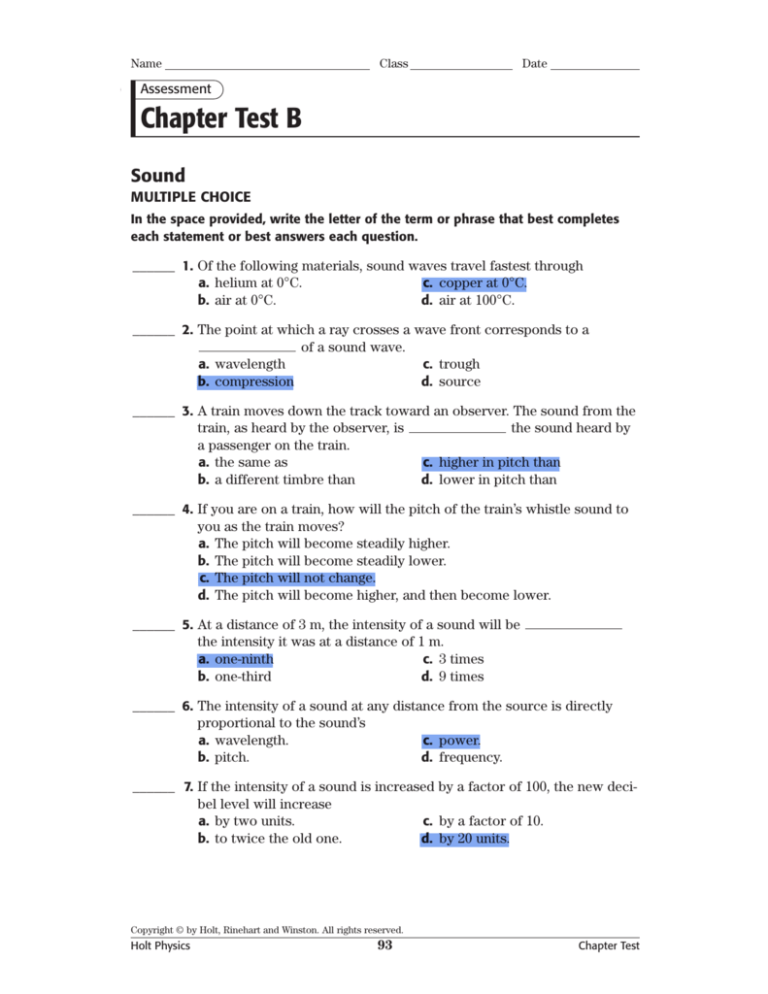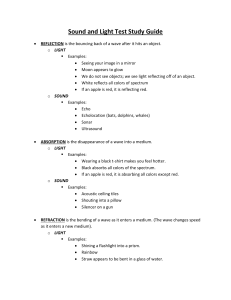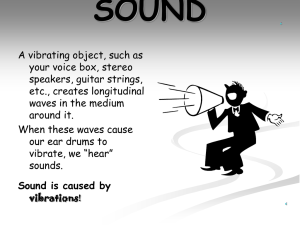
Name
Class
Date
Assessment
Chapter Test B
Sound
MULTIPLE CHOICE
In the space provided, write the letter of the term or phrase that best completes
each statement or best answers each question.
______ 1. Of the following materials, sound waves travel fastest through
a. helium at 0°C.
c. copper at 0°C.
b. air at 0°C.
d. air at 100°C.
______ 2. The point at which a ray crosses a wave front corresponds to a
of a sound wave.
a. wavelength
c. trough
b. compression
d. source
______ 3. A train moves down the track toward an observer. The sound from the
train, as heard by the observer, is
the sound heard by
a passenger on the train.
a. the same as
c. higher in pitch than
b. a different timbre than
d. lower in pitch than
______ 4. If you are on a train, how will the pitch of the train’s whistle sound to
you as the train moves?
a. The pitch will become steadily higher.
b. The pitch will become steadily lower.
c. The pitch will not change.
d. The pitch will become higher, and then become lower.
______ 5. At a distance of 3 m, the intensity of a sound will be
the intensity it was at a distance of 1 m.
a. one-ninth
c. 3 times
b. one-third
d. 9 times
______ 6. The intensity of a sound at any distance from the source is directly
proportional to the sound’s
a. wavelength.
c. power.
b. pitch.
d. frequency.
______ 7. If the intensity of a sound is increased by a factor of 100, the new decibel level will increase
a. by two units.
c. by a factor of 10.
b. to twice the old one.
d. by 20 units.
Copyright © by Holt, Rinehart and Winston. All rights reserved.
Holt Physics
93
Chapter Test
Name
Class
Date
Chapter Test B continued
______ 8. The Tacoma Narrows bridge collapsed in 1940 when winds caused
to build up in the bridge.
a. a compression wave
c. a standing wave
b. a longitudinal wave
d. friction
______ 9. For a standing wave in an air column in a pipe that is open at both
ends, there must be at least
a. one node and one antinode.
b. two nodes and one antinode.
c. two antinodes and one node.
d. two nodes and two antinodes.
______10. If a guitar string has a fundamental frequency of 500 Hz, what is the
frequency of its second harmonic?
a. 250 Hz
c. 1000 Hz
b. 750 Hz
d. 2000 Hz
______11. Musical instruments of different types playing the same note may often
be identified by the
of their sounds.
a. pitch
c. fundamental frequency
b. intensity
d. timbre
______12. How many beats per second are heard when two vibrating tuning forks
having frequencies of 342 Hz and 345 Hz are held side by side?
a. 687 Hz
c. 5 Hz
b. 343.5 Hz
d. 3 Hz
(a)
(b)
t1
t2
Destructive
interference
Constructive
interference
t3
Destructive
interference
______13. In the figure shown above, a beat occurs at
a. t1.
c. t3.
b. t2.
d. t1 and t3.
Copyright © by Holt, Rinehart and Winston. All rights reserved.
Holt Physics
94
Chapter Test
Name
Class
Date
Chapter Test B continued
SHORT ANSWER
14. Unlike a transverse wave on a rope, sound travels as a(n)
wave.
longitudinal wave
15. Each trough of a sine wave used to represent a sound wave corresponds to
a(n)
of the sound wave.
rarefaction (low pressure)
16. What happens to pitch when the frequency of a sound wave increases?
the pitch goes higher
17. Under what conditions can a spherical wave front be regarded as a plane
wave front? Explain.
If you are a long distance away from the source - the radius of curvature is bigger
18. Describe any changes in pitch of the sound a stationary observer hears from
the siren of an ambulance as the ambulance passes the observer.
As the ambulance moving towards the observer, he hears a higher pitch. Once it passes, the observers hears a lower pitch.
19. What happens to the intensity of a sound as the distance from the source
increases from 10 m to 20 m? Explain.
The intensity drops to 1/4 of its original magnitude, because intensity is inversely proportional to the
square of distance.
20. Suppose you play a music CD in a room where there is a piano. During the
silence between songs, you hear a musical note coming from the piano, but
no one has touched the piano. Explain your observation.
The note played on a CD matched the natural frequency of one of the strings and resonance occured.
Copyright © by Holt, Rinehart and Winston. All rights reserved.
Holt Physics
95
Chapter Test
Name
Class
Date
Chapter Test B continued
21. It is possible for a highly amplified musical note to cause a crystal goblet to
shatter. Explain how this might occur.
If the note's frequency matches that of the goblet, resonance will occur. And if the note is amplified
enough (played close to the goblet), played for a long enough time, the vibrations in the goblet will
increase and cause it to shatter.
PROBLEM
22. What is the intensity of sound waves produced by a trumpet at a distance of
1.6 m when the power output of the trumpet is 0.30 W?
9.3x10^-3 W/m^2
23. What length of guitar string would vibrate at a fundamental frequency of
825 Hz if the string is stretched so that the velocity of waves on the string is
577 m/s?
0.350 m
24. Closed-end organ pipes often have a movable closure that can be adjusted up
or down to tune the pipe to the desired pitch. The resonant length of a certain
closed-end pipe is 27.5 cm. By how many centimeters must this pipe be shortened or lengthened in order to tune it to a fundamental frequency of 349 Hz?
The pipe is in an environment in which the speed of sound is 348 m/s.
The length of the pipe should be 25.0 cm, so it needs to be shortened by 2.5 cm
25. As two notes are sounded, 6 beats per second are heard. The frequency of one
note is 571 Hz. What is the frequency of the other note?
577 Hz or 565 Hz
Copyright © by Holt, Rinehart and Winston. All rights reserved.
Holt Physics
96
Chapter Test









